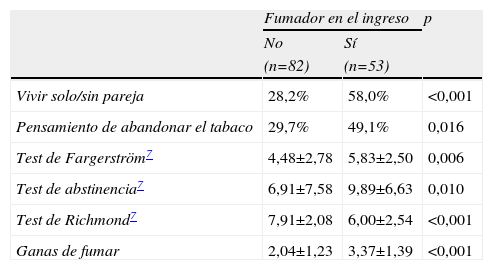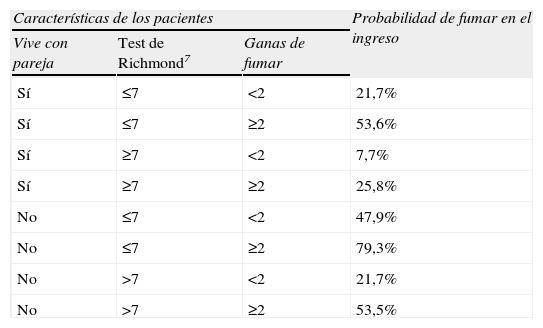Conocer la prevalencia del consumo de tabaco en fumadores durante un ingreso hospitalario y determinar las variables asociadas con dicho consumo. Analizar si se han producido cambios en la prevalencia tras la entrada en vigor de la ley antitabaco 28/2005.
Material y métodosEstudio transversal de casos consecutivos en la población ingresada en un hospital, antes y después de la entrada en vigor de la citada ley. Se encuestaron 1189 enfermos, de los cuales 184 (15,4%) se declararon fumadores activos a su llegada al hospital. De estos, 135 (73,3%) aceptaron participar en el estudio. Entre las 72–96h tras su admisión, completaron una encuesta que incluía datos sobre su hábito tabáquico, situación social y consumo de tabaco durante el ingreso. Se realizó una medición del monóxido de carbono en aire espirado utilizando un cooxímetro. Se consideraron como fumadores dentro del hospital los pacientes que admitieron haber fumado durante su estancia hospitalaria y/o aquellos en los que el resultado de la cooximetría fue mayor de 6ppm.
ResultadosDe los 135 pacientes que completaron el estudio, 53 (39,3%) fumaron durante el ingreso, antes de la ley 34,2% (IC 95%: 22,6–45,8%) y después de la ley 45,1% (IC 95%: 31,9–58,3%). No hallamos diferencias significativas en los 2 años de recogida de datos (p=0,26). Las variables que de forma independiente se asociaron al consumo de tabaco durante la estancia hospitalaria fueron: vivir solo/sin pareja (p=0,015, OR 2,85, IC 95% 1,22–6,65), test de Richmond menor o igual a 7 (p=0,002, OR 3,64, IC 95% 1,60–8,31) y puntuación en la variable «ganas de fumar» mayor o igual a 2 (p<0,001, OR 4,85, IC 95% 2,08–11,28). Mediante la valoración de estos parámetros se puede determinar la probabilidad de que un paciente fume durante el ingreso hospitalario (79,3% si el paciente vive solo, test de Richmond <7 y encuesta sobre «ganas de fumar» <2.
ConclusionesEl consumo de tabaco sigue siendo un problema importante en los servicios médicos de los hospitales. Mediante la valoración de 3 variables sencillas puede determinarse la probabilidad de que un paciente fume durante el ingreso.
To know the prevalence of tobacco consumption in smokers during a hospital say and determine the variables associated with this consumption. To analyze if changes have occurred in its prevalence after the entry into force of the anti-tobacco law 28/2005.
Material and methodsA cross-sectional study of consecutive cases in the population admitted to a hospital before and after the entry into force of said law. A total of 1189 patients were surveyed. Of these 184 (15.4%) stated they were active smokers when the arrived to the hospital. A total of 135 (73.3%) of these accepted to participate in the study. Between 72 and 96 hours after their admission, they filled out a survey that included data on the smoking habit, social status and consumption of tobacco during their hospital stay. Carbon monoxide in the expired air was measured with a cooximeter. Smokers within the hospital were considered to be those patients who admitted having smoked during their hospital stay and/or those in whom the cooximeter result was greater than 6ppm.
ResultsOf the 135 patients who completed the study, 53 (39.3%) smoked during their stay, 34.2% (95% CI: 22.6%–45.8%) before the law and 45.1% (95% CI: 31.9%–58.3%) after the law. No significant differences were found during the 2 years in which the data were collected (p=0.26). The variables which were independently associated to tobacco consumption during the hospital stay were: living along/without a partner (p=0.015, OR 2.85, 95% CI 1.22–6.65), Richmond test less than or equal to 7 (p=0.002, OR 3.64, 95% CI 1.60–8.31) and score on the variable “desire to smoke” greater than or equal to 2 (p<0.001, OR 4.85, 95% CI 2.08–11.28). Based on the evaluation of these parameters, the likelihood that a patient would smoke during the hospital stay can be determined (79.3% if the patient lives along, Richmond test <7 and survey on "desire to smoke” <2).
ConclusionsTobacco consumption continues to be an important problem in the medical departments of the hospitals. Through the evaluation of 3 simple variables, it is possible to determine if a patient will smoke during the hospitalization.
Artículo
Diríjase desde aquí a la web de la >>>FESEMI<<< e inicie sesión mediante el formulario que se encuentra en la barra superior, pulsando sobre el candado.

Una vez autentificado, en la misma web de FESEMI, en el menú superior, elija la opción deseada.

>>>FESEMI<<<








